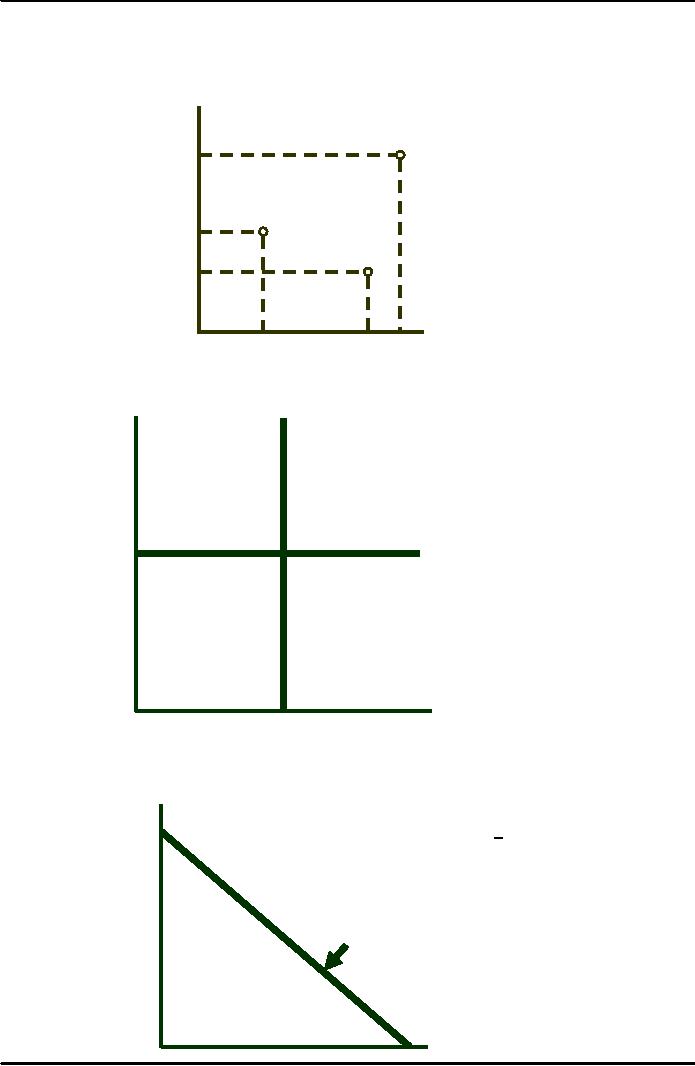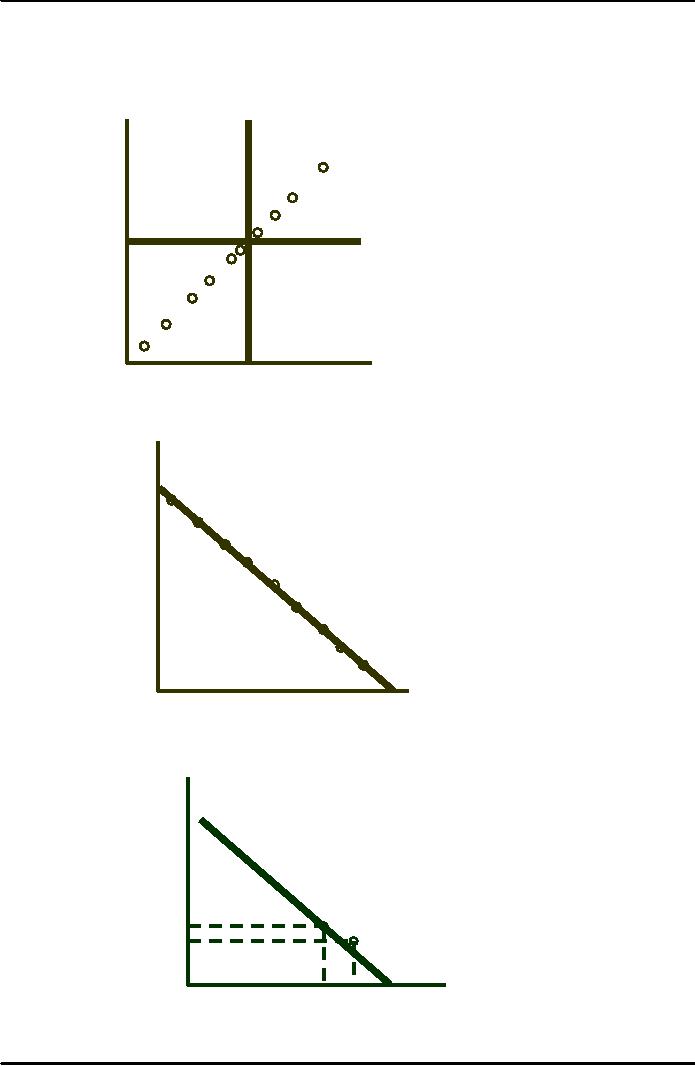 |
Bundling:Consumption Decisions When Products are Bundled |
| << Airline Fares:Elasticities of Demand for Air Travel, The Two-Part Tariff |
| Bundling:Mixed Versus Pure Bundling, Effects of Advertising >> |

Microeconomics
ECO402
VU
Lesson
37
Bundling
Bundling
is packaging two or more
products to gain a pricing
advantage.
Conditions
necessary for
bundling
Heterogeneous
customers
Price
discrimination is not
possible
Demands
must be negatively
correlated
An
example: Leasing Movie X &
Movie Y
The
reservation prices for each
theater and movie
are:
Movie
X
Movie
Y
Theater
A
$12,000
$3,000
Theater
B
$10,000
$4,000
Renting
the movies separately would
result in each theater
paying the lowest
reservation
price
for each movie:
Maximum
price X
=
$10,000
Maximum
price Y
=
$3,000
Total
Revenue = $26,000
If
the movies are
bundled:
Theater
A
will
pay $15,000 for
both
Theater
B
will
pay $14,000 for
both
If
each were charged the
lower of the two prices,
total revenue will be
$28,000.
Relative
Valuations
Negative
Correlated: Profitable to
Bundle
A
pays
more for X
($12,000)
than B
($10,000).
B
pays
more for Y
($4,000)
than A
($3,000).
If the
demands were positively
correlated (Theater A would
pay more for both
films as
shown)
bundling would not result in
an increase in revenue.
Movie
X
Movie
Y
Theater
A
$12,000
$4,000
Theater
B
$10,000
$3,000
If
the movies are
bundled:
Theater
A
will
pay $16,000 for
both
Theater
B
will
pay $13,000 for
both
If
each were charged the
lower of the two prices,
total revenue will be
$26,000, the same as
by
selling the films
separately.
Bundling
Scenario: Two different
goods and many
consumers
Many consumers
with different reservation
price combinations for two
goods
171

Microeconomics
ECO402
VU
Reservation
Prices
r2
Consumer
(reservation
C
price
Good 2)
$10
Consumer
A is
willing
to pay up to
$3.25
for good 1 and
Consumer
up
to $6 for good 2.
$6
A
Consumer
$5
B
$3.25
r1
(reservation
price
Good
1)
$3.25
$5
$8.25
$10
Consumption
Decisions When Products are
Sold Separately
R1 <
P
R1 >
P
r2
Consumers
fall into
1
1
four
categories based
R2 >
P2
R2 >
P2
on
their reservation
price.
II
I
Consumers
Consumers
buy
buy
P2
R1 <
P
R1 >
P
1
1
R2 <
P2
R2 <
P2
III
IV
Consumers
Consumers
buy
buy
r1
P1
Consumption
Decisions When Products are
Bundled
r2
Consumers
buy the bundle
when
r1 + r2
> PB
I
(PB =
bundle
price).
Consumers
PB =
r1 + r2
or r2 =
PB - r1
buy
bundle
Region
1: r
> PB
(r
> PB)
Region
2: r
< PB
r2 =
PB - r1
I
Consumers
do
not
buy bundle
(r
< PB)
r1
172

Microeconomics
ECO402
VU
The
effectiveness of bundling depends
upon the degree of negative
correlation between
the
two
demands.
Reservation
Prices
r2
If
the demands are
perfectly
positively
correlated,
the firm
will
not gain by bundling.
It
would earn the same
profit
by selling the
goods
separately.
P2
r1
P1
Reservation
Prices
r2
If
the demands are
perfectly
negatively
correlated
bundling is the
ideal
strategy--all the
consumer
surplus can
be
extracted and a
higher
profit
results.
r1
Movie
Example
(Movie
X) r2
10,000
Bundling
pays due
to
negative
correlation
5
000
B
4,000
A
3,000
r1
10,000
12,00
14,000
5,000
(Movie
Y)
173
Table of Contents:
- ECONOMICS:Themes of Microeconomics, Theories and Models
- Economics: Another Perspective, Factors of Production
- REAL VERSUS NOMINAL PRICES:SUPPLY AND DEMAND, The Demand Curve
- Changes in Market Equilibrium:Market for College Education
- Elasticities of supply and demand:The Demand for Gasoline
- Consumer Behavior:Consumer Preferences, Indifference curves
- CONSUMER PREFERENCES:Budget Constraints, Consumer Choice
- Note it is repeated:Consumer Preferences, Revealed Preferences
- MARGINAL UTILITY AND CONSUMER CHOICE:COST-OF-LIVING INDEXES
- Review of Consumer Equilibrium:INDIVIDUAL DEMAND, An Inferior Good
- Income & Substitution Effects:Determining the Market Demand Curve
- The Aggregate Demand For Wheat:NETWORK EXTERNALITIES
- Describing Risk:Unequal Probability Outcomes
- PREFERENCES TOWARD RISK:Risk Premium, Indifference Curve
- PREFERENCES TOWARD RISK:Reducing Risk, The Demand for Risky Assets
- The Technology of Production:Production Function for Food
- Production with Two Variable Inputs:Returns to Scale
- Measuring Cost: Which Costs Matter?:Cost in the Short Run
- A Firm’s Short-Run Costs ($):The Effect of Effluent Fees on Firms’ Input Choices
- Cost in the Long Run:Long-Run Cost with Economies & Diseconomies of Scale
- Production with Two Outputs--Economies of Scope:Cubic Cost Function
- Perfectly Competitive Markets:Choosing Output in Short Run
- A Competitive Firm Incurring Losses:Industry Supply in Short Run
- Elasticity of Market Supply:Producer Surplus for a Market
- Elasticity of Market Supply:Long-Run Competitive Equilibrium
- Elasticity of Market Supply:The Industry’s Long-Run Supply Curve
- Elasticity of Market Supply:Welfare loss if price is held below market-clearing level
- Price Supports:Supply Restrictions, Import Quotas and Tariffs
- The Sugar Quota:The Impact of a Tax or Subsidy, Subsidy
- Perfect Competition:Total, Marginal, and Average Revenue
- Perfect Competition:Effect of Excise Tax on Monopolist
- Monopoly:Elasticity of Demand and Price Markup, Sources of Monopoly Power
- The Social Costs of Monopoly Power:Price Regulation, Monopsony
- Monopsony Power:Pricing With Market Power, Capturing Consumer Surplus
- Monopsony Power:THE ECONOMICS OF COUPONS AND REBATES
- Airline Fares:Elasticities of Demand for Air Travel, The Two-Part Tariff
- Bundling:Consumption Decisions When Products are Bundled
- Bundling:Mixed Versus Pure Bundling, Effects of Advertising
- MONOPOLISTIC COMPETITION:Monopolistic Competition in the Market for Colas and Coffee
- OLIGOPOLY:Duopoly Example, Price Competition
- Competition Versus Collusion:The Prisoners’ Dilemma, Implications of the Prisoners
- COMPETITIVE FACTOR MARKETS:Marginal Revenue Product
- Competitive Factor Markets:The Demand for Jet Fuel
- Equilibrium in a Competitive Factor Market:Labor Market Equilibrium
- Factor Markets with Monopoly Power:Monopoly Power of Sellers of Labor